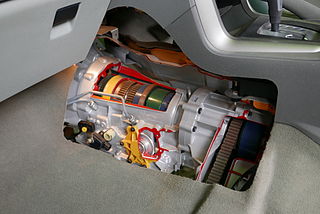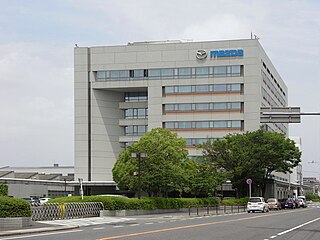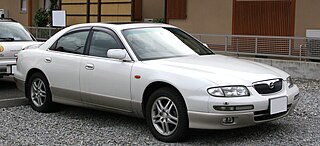
The Mazda MX-3 is a four-seat coupé manufactured and marketed by Mazda, introduced at the Geneva Auto Show in March 1991 and marketed for model years 1992-1998.

The Mazda Capella is a mid-size car that was manufactured by Mazda from 1970 to 2002. Sold in the Japanese domestic market under the Capella name, the vehicle was also commonly known in other major markets as the Mazda 626. Ford, Mazda's partner at the time, would also use the Capella platform to create the Ford Telstar and Ford Probe. 4,345,279 of the 626 and Telstar models were sold worldwide.
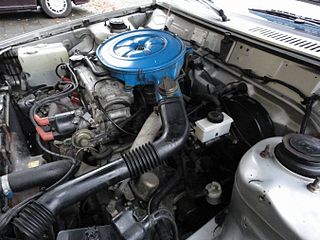
The F engine family from Mazda is a mid-sized inline-four piston engine with iron block, alloy head and belt-driven SOHC and DOHC configurations. Introduced in 1983 as the 1.6-litre F6, this engine was found in the Mazda B-Series truck and Mazda G platform models such as Mazda 626/Capella as well as many other models internationally including Mazda Bongo and Ford Freda clone, Mazda B-series based Ford Courier, Mazda 929 HC and the GD platform-based Ford Probe
The G family of Mazda engines is a family of large inline-four piston engines that was commercialized from 1989 to 2001. The series started at 2.6 L for the Mazda B-Series truck from 1988. Prior to that, a 2.6 L Mitsubishi engine had been used.
The Mazda B-series engine - not to be confused with the Mazda B-Series truck - is a small-sized, iron-block, inline four-cylinder with belt-driven SOHC and DOHC valvetrain ranging in displacement from 1.1 to 1.8 litres. It was used from front-wheel drive economy applications to the turbocharged full-time 4WD 323 GTX and rear-wheel drive Miata as well as numerous other models. The Mazda B-series is a "non-interference" design, meaning that breakage of its timing belt does not result in damage to valves or pistons, because the opening of the valves, the depth of the combustion chamber and the shaping of the piston crown allow sufficient clearance for the open valves in any possible piston position.

The Mazda K-series automobile engine is a short stroke 60° 24-valve V6 with belt-driven DOHC and all-alloy construction. Displacements range from 1.8 L to 2.5 L. They all use a 27-degree DOHC valvetrain with directly actuated hydraulic bucket lifters. The K-series also features a highly rigid aluminum split-crankcase engine block design with 4-bolt mains with additional bolts securing the lower block, an internally balanced forged steel crankshaft with lightweight powder forged carbon steel connecting rods. They were designed with the intent of being as compact as possible for short-hood front-wheel drive applications.
The Mazda C platform is an automobile platform for midsize cars. It was derived from the Mazda G platform used in the Mazda Capella/626. Unlike the wider, early-1990s 626, cars based on the C platform were limited to 1700 mm in width.
The Mazda G platform is an automobile platform for midsize cars. It has been used by a number of vehicles from Mazda in Japan and abroad.
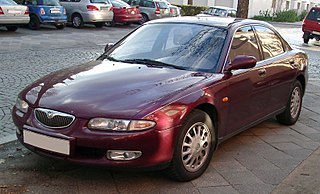
This article is about the 1990s compact executive car, not to be confused with the current Mazda6 midsize sedan
"Amati 300" redirects here. For more information about the proposed luxury division, see Amati Cars

The Turbo-Hydramatic 125 was the first in a line of automatic transmissions from General Motors designed for transverse engine application. Introduced in 1980, the line evolved into today's 4T40/45/65/80 line.

Mazda North American Operations (MNAO), which includes Mazda Motor of America, Inc., is Mazda Motor Corporation's North American arm, and constitutes the largest component of that company outside Japan. The company has its headquarters in Irvine, California and is headed by Masahiro Moro.
The CD4E is a 4-speed automatic transaxle for front-wheel-drive cars from 1994 to 2007. It was manufactured at Ford's Batavia Transmission plant starting in 1994. The CD4E was called the LA4A-EL by Mazda and is also known as the 4F44E internally to Ford.
The F3A is a 3-speed automatic transmission from Mazda. The transmission is hydraulically controlled, and used on front wheel drive vehicles which have a small engine. It was equipped with a centrifugal type torque converter clutch on later models such as the Ford Aspire.
The 4F27E is an electronically controlled 4-speed automatic transmission, used by Ford and Mazda. Ford's name for this transmission is 4F27E, Mazda's name for this transmission is FN4A-EL. This dipstick for this transmission says "M V" on the dipstick handle in Mazda vehicles.
The F-4EAT was a 4-speed, electronically controlled automatic transmission developed by Mazda and JATCO starting in 1990. It was also later produced by Ford Motor Company from 1991 to 2003, to replace the aging, 3-speed/hydraulic controlled ATX. It is referred to as the F4A-EL by Mazda and Kia who also used this transmission. This transmission is an updated Mazda F3A transmission, 3 speed hydraulic controlled transmission. The F-4EAT uses electronic, computer controls, a 4th gear overdrive, has a lock up torque converter and differential. It used a computer-controlled speed sensor for the speedometer.
Roger Dowson Engineering, also known as RD Motorsport, was an automotive engineering company, and an auto racing team run by Roger Dowson. The company was founded in 1982, and was most notable for running the works MG Metros in the British Saloon Car Championship in 1983 and the works Mazda teams in the British Touring Car Championship from 1992 until 1994.
This page is based on this
Wikipedia article Text is available under the
CC BY-SA 4.0 license; additional terms may apply.
Images, videos and audio are available under their respective licenses.
